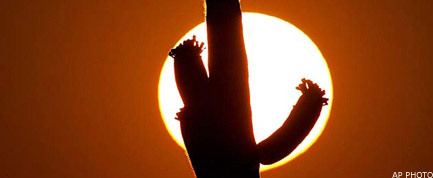Beware Cheap Sunglasses

Summer is rapidly approaching. That means sunshine, the beach, and kiosks selling sunglasses with dubious information about the true level of UV protection they offer.
UV light can damage the eyes by essentially giving the cornea a sunburn or, in the long run, causing cataracts and retinal and macular degeneration. A good pair of sunglasses that blocks UV can help your image as well as help you image. Doctors recommend sunglasses that block over 98 percent of all UV.
Unfortunately, the non-prescription sunglasses industry is weakly regulated, and even bold words in its advertising such as "UV absorbing" or "blocks most UV light" might mean nothing.
"There is no government regulating power for the classification of sunglasses," said Donald D'Amico, chair of ophthalmology at New York-Presbyterian Hospital. As a result, some companies misrepresent how much protection their sunglasses offer.
I saw the light
UV, short for ultraviolet, is a higher-energy, invisible form of light. The sun typically emits three kinds: a higher-energy and very harmful form, called UVC, effectively blocked by atmosphere; a slightly less energetic form, called UVB, which causes sunburn and skin cancers, but which is also needed to activate vitamin D in the skin; and the lower-energy UVA, which causes skin wrinkles and, indirectly, some skin cancers. Over 98 percent of the UV reaching the Earth's surface is UVA.
UVA and UVB can cause the same kind of damage to the eyes as they do to the skin, by breaking chemical bonds, particularly DNA, and causing mutations and cell-division errors that can lead to disease.
Get the world’s most fascinating discoveries delivered straight to your inbox.
Because UV is invisible, you cannot tell by simply looking at a pair of sunglasses how much UV light the lenses filter. The darkness of the glasses is not a true indication. And even if you have a UV laser to shine at your sunglasses, you'd have to be even further in the realm of science geek and possess UV detectors to see what is getting through the lens.
Cheap sunglasses
Price doesn't matter, either. Many studies — some scientific, published in peer-reviewed journals, and others more on the anecdotal side, by fearless television reporters — have found $15 sunglasses to be as good or better at blocking UV as $400 designer shades.
But there is a limit: Very cheap sunglasses tend to offer little or no UV protection, which might be more damaging to your eyes than wearing nothing at all. By blocking visible light, sunglasses will cause your eyes to dilate slightly; and if the sunglasses are cheap with no UV protection, then even more UV might get into your eyes.
So what's a fashion-conscious, health-conscious consumer to do? D'Amico, whose organization issued a statement about sunglasses and eye safety last week, recommends sticking to name brands, which are mostly likely to be truthful in their advertising.
FDA to the rescue
In the United States, the FDA regulates nonprescription sunglasses as medical devices. What little teeth the FDA does have in regulating UV protection comes in its ability to uphold truth in specific labeling. That is, "98 percent" or "100 percent" UV protection must mean exactly that or... or... the company in violation will get a mean letter from the FDA. By using non-quantifiable terms such as "most UV," though, companies can skirt the FDA regulation.
One way to be sure about UV protection is to bring your sunglasses to your eye doctor, who likely has the geeky equipment to test them. Or you can buy a pair from Europe, where the European Union regulates a rating system in which "3" means full protection and "2" means adequate. Australia, too, has solid standards, for their largely Caucasian population transplanted to sunny climes close to a massive hole in the ozone layer has the highest skin cancer rates in the world.
Despite the strength of the lens, a good deal of UV light can still enter your eyes through the sides. The tighter the fit, the better the protection. While you might find Bono's wrap-around style of sunglasses to be a bit trying, the man is on to something.
- Smart Sunglasses Change Color on Demand
- You and the Sun: 10 Burning Questions
- 10 Easy Paths to Self Destruction
Christopher Wanjek is the author of the books “Bad Medicine” and “Food At Work.” Got a question about Bad Medicine? Email Wanjek. If it’s really bad, he just might answer it in a future column. Bad Medicine appears each Tuesday on LIveScience.

Christopher Wanjek is a Live Science contributor and a health and science writer. He is the author of three science books: Spacefarers (2020), Food at Work (2005) and Bad Medicine (2003). His "Food at Work" book and project, concerning workers' health, safety and productivity, was commissioned by the U.N.'s International Labor Organization. For Live Science, Christopher covers public health, nutrition and biology, and he has written extensively for The Washington Post and Sky & Telescope among others, as well as for the NASA Goddard Space Flight Center, where he was a senior writer. Christopher holds a Master of Health degree from Harvard School of Public Health and a degree in journalism from Temple University.


